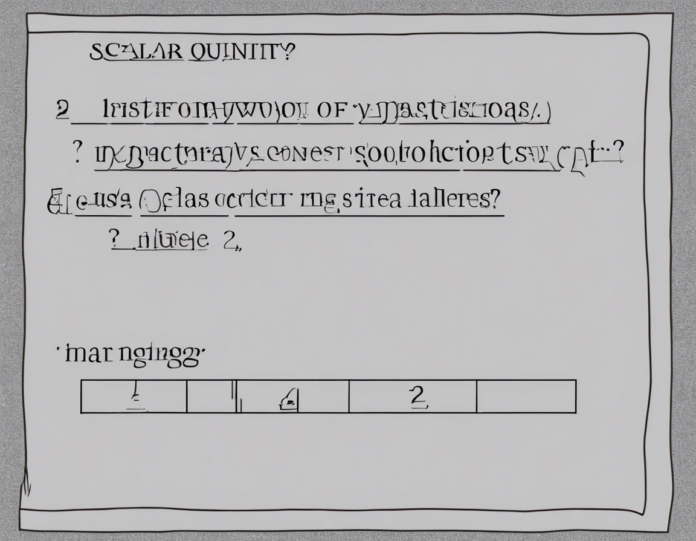In the realm of physics and mathematics, scalar and vector quantities play a fundamental role in describing various physical phenomena. Understanding the difference between the two is crucial for solving problems in mechanics, electromagnetism, and other branches of physics. In this article, we will delve into the definitions of scalar and vector quantities, explore their key characteristics, and discuss how they are applied in different scientific contexts.
Scalar Quantities
Scalar quantities are defined as physical quantities that have magnitude (size or amount) only and no specified direction. These quantities are completely described by their magnitude and units, regardless of the direction. Some common examples of scalar quantities include time, temperature, mass, volume, energy, and speed.
Characteristics of Scalar Quantities:
- Magnitude: Scalar quantities are characterized by their size or amount.
- Units: They are measured in specific units (e.g., seconds for time, kilograms for mass).
- No Direction: Scalar quantities do not have a specific direction associated with them.
- Addition and Subtraction: Scalar quantities can be added or subtracted algebraically.
Scalar quantities are used in various scientific contexts to represent quantities that do not have a directional aspect. For example, the speed of an object can be described as a scalar quantity, as it only involves the magnitude of the velocity without specifying a direction.
Vector Quantities
Vector quantities, on the other hand, are physical quantities that have both magnitude and direction. These quantities are represented by arrows, where the length of the arrow corresponds to the magnitude, and the direction of the arrow indicates the direction. Common examples of vector quantities include displacement, velocity, acceleration, force, and momentum.
Characteristics of Vector Quantities:
- Magnitude and Direction: Vector quantities have both magnitude and direction.
- Units: They are measured in specific units, similar to scalar quantities.
- Addition and Subtraction: Vector quantities follow the rules of vector addition and subtraction.
- Representation: Vectors are represented graphically by arrows in a specific direction.
Vector quantities are essential in physics as they represent physical quantities that involve both size and direction. For example, when describing the velocity of an object, it is crucial to include both the speed and the direction of motion, making it a vector quantity.
Key Differences Between Scalar and Vector Quantities
- Magnitude vs. Magnitude and Direction: The primary difference lies in the fact that scalar quantities have magnitude only, while vector quantities have both magnitude and direction.
- Representation: Scalars are represented by a single numerical value, while vectors are represented by arrows indicating both magnitude and direction.
- Algebraic Operations: Scalars can be added or subtracted using regular algebraic rules, whereas vectors require vector addition and subtraction.
- Physical Interpretation: Scalar quantities describe quantities such as time, mass, and temperature, while vectors describe quantities like velocity, force, and acceleration.
Applications of Scalar and Vector Quantities
Both scalar and vector quantities find applications in various scientific fields, including physics, engineering, and mathematics. Understanding the distinction between the two is crucial for solving problems and analyzing physical phenomena accurately.
- Scalar Quantities: Widely used in calculations involving energy, work, temperature, pressure, and speed.
- Vector Quantities: Essential for analyzing motion, forces, velocities, accelerations, and other quantities that involve direction.
In physics, many physical laws and principles involve a combination of scalar and vector quantities. For instance, when calculating work done by a force (a vector quantity) on an object, the displacement (also a vector quantity) and force need to be considered together, highlighting the interaction between scalar and vector aspects in physical phenomena.
Frequently Asked Questions (FAQs)
- What is the fundamental difference between scalar and vector quantities?
-
Scalar quantities have magnitude only, while vector quantities have both magnitude and direction.
-
How are scalar quantities represented in equations?
-
Scalar quantities are represented by single numerical values without any directional components.
-
Can a quantity be both scalar and vector?
-
No, a quantity is either scalar (magnitude only) or vector (magnitude and direction).
-
What are some examples of scalar quantities in everyday life?
-
Time, temperature, mass, volume, and speed are common examples of scalar quantities.
-
How are vectors represented graphically?
-
Vectors are represented as arrows, where the length denotes the magnitude and the direction of the arrow represents the direction.
-
What is the significance of vector addition in physics?
-
Vector addition is crucial for determining the resultant of multiple vectors acting on an object, providing insight into the overall effect of these vectors.
-
Why are scalar and vector quantities important in physics?
-
Scalar and vector quantities help in accurately describing and analyzing physical phenomena by incorporating both size and direction where necessary.
-
How do scalar and vector quantities differ in mathematical operations?
-
Scalar quantities can be added or subtracted algebraically, while vector quantities require vector addition and subtraction to consider both magnitude and direction.
-
In which scientific fields are scalar quantities predominantly used?
-
Scalar quantities are commonly applied in fields such as thermodynamics, fluid dynamics, and kinematics where only size or amount is relevant.
-
What role do vector quantities play in engineering applications?
- Vector quantities are essential in engineering for analyzing forces, velocities, and directions of motion in mechanical systems and structural design.
In conclusion, understanding the distinction between scalar and vector quantities is essential for mastering various scientific concepts and solving complex problems in physics and mathematics. By differentiating between these two types of quantities and recognizing their unique characteristics and applications, one can develop a deeper understanding of how physical phenomena are described and analyzed in the scientific world.
